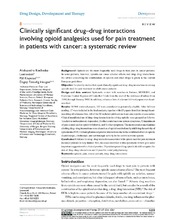Clinically significant drug–drug interactions involving opioid analgesics used for pain treatment in patients with cancer: a systematic review
Peer reviewed, Journal article
Published version

View/
Date
2015-09-16Metadata
Show full item recordCollections
Original version
https://doi.org/10.2147/dddt.s86983Abstract
Background: Opioids are the most frequently used drugs to treat pain in cancer patients. In some patients, however, opioids can cause adverse effects and drug–drug interactions. No advice concerning the combination of opioids and other drugs is given in the current European guidelines. Objective: To identify studies that report clinically significant drug–drug interactions involving opioids used for pain treatment in adult cancer patients. Design and data sources: Systematic review with searches in Embase, MEDLINE, and Cochrane Central Register of Controlled Trials from the start of the databases (Embase from 1980) through January 2014. In addition, reference lists of relevant full-text papers were hand- searched. Results: Of 901 retrieved papers, 112 were considered as potentially eligible. After full-text reading, 17 were included in the final analysis, together with 15 papers identified through hand- searching of reference lists. All of the 32 included publications were case reports or case series. Clinical manifestations of drug–drug interactions involving opioids were grouped as follows: 1) sedation and respiratory depression, 2) other central nervous system symptoms, 3) impairment of pain control and/or opioid withdrawal, and 4) other symptoms. The most common mechanisms eliciting drug–drug interactions were alteration of opioid metabolism by inhibiting the activity of cytochrome P450 3A4 and pharmacodynamic interactions due to the combined effect on opioid, dopaminergic, cholinergic, and serotonergic activity in the central nervous system. Conclusion: Evidence for drug–drug interactions associated with opioids used for pain treatment in cancer patients is very limited. Still, the cases identified in this systematic review give some important suggestions for clinical practice. Physicians prescribing opioids should recognize the risk of drug–drug interactions and if possible avoid polypharmacy.
